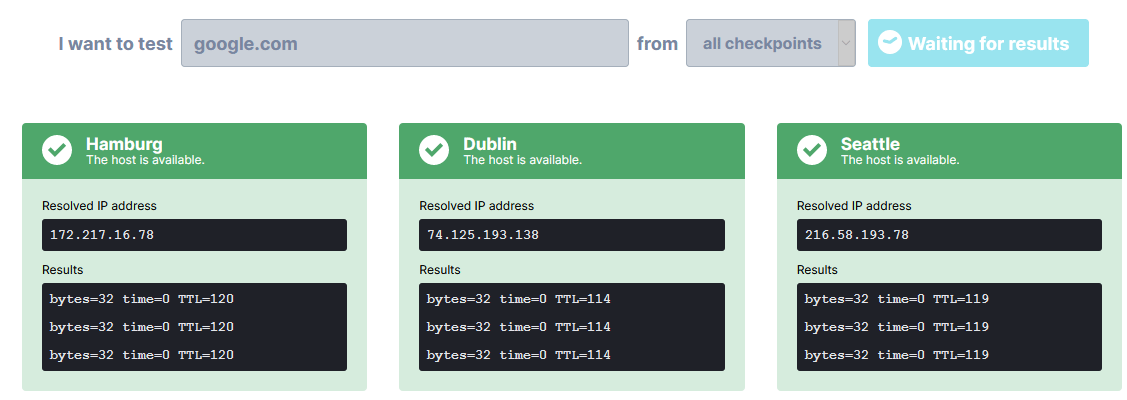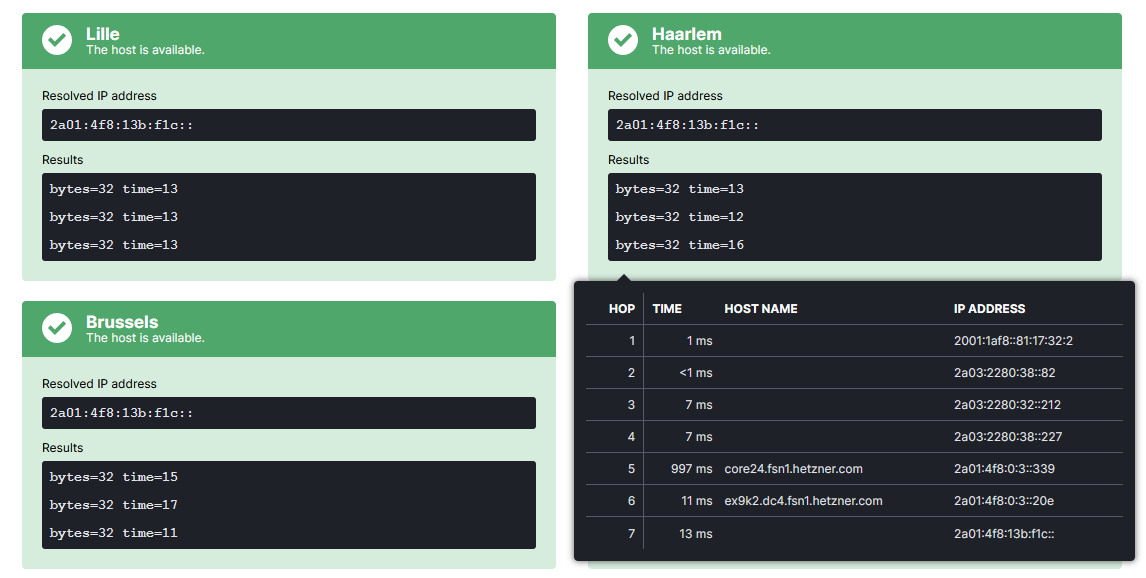Uptrends offers two free ping test tools: IPv4 Ping Test and IPv6 Ping Test. If you’re wondering why Uptrends has two separate tests that ping servers, you’re in the right place. Uptrends has two separate tests because the two addressing systems work independently of each other, often over the same network devices.
IPv4 is a bit zombie like. The aging protocol is zombie like because we keep pronouncing it dead, but it keeps hanging on. IPv6 is the faster and more resilient relative of the old 32-bit IPv4 addressing system, but the IPv6 adoption process has been slow—like rambling zombie slow with only a 33 percent adoption rate over the course of ten years.
The IPv6 architecture continues to expand, but meanwhile, IPv4 still handles most Internet traffic. So, when it comes time to test your IPv6 website, you may find it challenging to do without jumping through some hoops. That’s where Uptrends’ IPv6 Ping Test comes in by checking your website from 20 or more of Uptrends’ checkpoints with native support for IPv6.
A little IPv6 and IPv4 history
The Internet Protocol (IP) has gone through five revisions since the introduction of IPv4 in 1981. As a 32-bit addressing system (roughly 4.3 billion unique addresses), IPv4’s addressing capabilities fall short. Considering the number of websites and device connected to the Internet, 4.3 billion unique addresses is nothing.
To further illustrate the point, think about the number of devices you use every day that connect to the Internet, for example, phones, tablets, computers, gaming systems, televisions, speakers, thermostats, kitchen appliances, smart locks, and light bulbs. Now think about the other seven billion people on the planet and all their devices. There simply aren’t enough IPv4 addresses to go around.
With lots of networking wizardry, we’ve managed to stretch the number of available addresses well beyond the 4.3 billion addresses, but even so, we’ve run out of addresses over the last ten years. We just can’t continue to stretch IPv4 any longer.
IPv6 to the rescue… Well, sort of. IPv6 fixes many of the shortcomings of the old IPv4 system, but it requires its own infrastructure. IPv4 and IPv6 can exist side-by-side, but to get the full benefit of IPv6 beyond the almost inexhaustible number of 128-bit addresses, IPv6 requires its own implementation on every device and router between the client and the host. The simultaneous implementation of IPv4 and IPv6 on devices (called a dual-stack IP) is an ongoing process.
So, when you put in a URL, such as google.com, your browser will decide the fastest route between you and the host. If the browser can connect using IPv6, it will. Well, it most likely will, but you really don’t know which route you got. When it comes to testing your connections, you’ve got to know.
Testing IPv6 connections in an IPv4 world
Uptrends has a Ping Test Tool. You plug in the URL, and Uptrends conducts ping tests from around the world. This tool always uses IPv4 unless you put in the IPv6 address instead of the URL. You’ll notice in the screenshot below the resolved IP addresses are all IPv4 for Google.com, however Google also supports IPv6 connectivity. 
If you use the IPv6 address in place of the URL, Uptrends pings the server using IPv6, but the test isn’t as thorough. When you use the URL, Uptrends connects to the Domain Name System to resolve the URL to the correct IP address.
If you use the IP address instead of the URL, the DNS resolution is unnecessary, so the test skips this crucial part. Additionally, not all tests succeed because the selected checkpoints may not support IPv6 natively. We made a separate IPv6 Ping Test tool so that you get a comprehensive IPv6 ping test that includes the DNS resolve using checkpoints that natively support IPv6.
Uptrends’ IPv6 ping test tool
The IPv6 ping tool is super easy. Plug in a URL, and if the URL resolves to an IPv6 address, Uptrends displays the results (with traceroutes) from as many as 20 of its global checkpoints (see figure below). If the site doesn’t have an IPv6 address, you get a page full of failed ping tests (what did you expect?). If an end-to-end IPv6 connection isn’t possible, you also get an error from that location.

How do I know if my site supports IPv6?
It is super easy to check if your site supports IPv6. Uptrends’ free DNS report can let you know if your site has an IPv6 address. Just put in the URL. In your results, look for the A and the AAAA records (see figure below). The A record is your IPv4 addresses, and the AAAA record is your IPv6 addresses. If you don’t get back an AAAA record, your site doesn’t have an IPv6 address.

Proactively monitoring your IPv4 and IPv6 addresses
It is important to keep an eye on both protocol versions because one may work fine while requests fail on the other. Uptrends has two ways for you to automate and monitor your availability using both protocols: DNS Monitoring and HTTP/HTTPS monitors for websites and web services.
DNS Monitoring for IPv4 and IPv6
Your DNS records send users to your site based on the IP address. If your DNS records are corrupted or tampered with, some, if not all, of your users won’t reach your servers. It is also very possible that one IP version is working when the other version is not. For this reason, we recommend that you monitor both protocols.
Uptrends DNS monitors compare the record value you set up in your monitor to the value coming from the DNS servers. If the values don’t match, Uptrends sends you an alert to the problem (see figure below).

Website and web service availability monitoring for IPv4 and IPv6
Your website or web service availability may differ from IPv4 and IPv6 due to network issues. Uptrends’ Availability Monitoring for websites and web services allows you to specify the IP version for your testing (see figure below). Set up a monitor for each protocol version to ensure availability.
Takeaways
- IPv6 adoption grows each year.
- IPv4’s IP addresses are depleted.
- Both IPv4 and IPv6 will continue to exist side by side while the infrastructure to support IPv6 continues to expand.
- Availability over each protocol may vary based on DNS or network issues.
- Uptrends has over 220 worldwide checkpoints, with more than half of those supporting IPv6 natively.
- With Uptrends, monitoring either protocol takes just a few quick clicks.
Do you want to try Uptrends with IPv6 monitoring support for free? Uptrends offers a commitment and credit card free 30-day trial. Try everything Uptrends offers. We recommend you sign up for the Business trial so you can see everything Uptrends has to offer.




